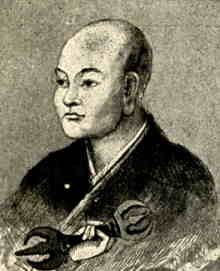SelfDefinition.Org
Sokushin-Jobutsu-Giby Kukai
(Kobo Daishi)
Principle Of Attaining Buddhahood With The Present Body
Translated by Hisao Inagaki

2. Text-Translation
I. SCRIPTURAL EVIDENCE
Question: Various sutras and treatises expound attainment of Buddhahood in three (asamkhya) kalpas. What scriptural evidence is there to establish the principle of attaining Buddhahood with the present body? Answer: The Tathagata expounds it in the Esoteric Pitaka.
What is the exposition in the sutras?
(1) The Diamond Peak Sutra says,
Those who practice this Samadhi
Will realize Buddha's Bodhi with the present (body).
"This Samadhi" refers to the Samadhi of One Letter (i.e. BHRUM) representing the Bhagavat Mahavairocana incarnated as a Golden Cakravartin.
(2) Again, it is said,
If there are beings who encounter this teaching
And practice it diligently, day and night, throughout the four periods of day,
They will attain the stage of Joy in this life
And realize Enlightenment after sixteen lives.
I explain: "This teaching" refers to the Great King Teaching of Samadhi realized inwardly by the Dharmakaya Buddha. "Stage of Joy" is not the first bhumi mentioned in the exoteric teachings; it is the first stage of our Buddha-vehicle, as fully explained in the section on stages. "Sixteen lives" refers to the lives of the sixteen great Bodhisattvas; they are fully explained in the section on stages.
(3) Again, it is said,
"If one practices in accordance with this supreme principle,
One will attain the highest Enlightenment in this life.
(4) Again, it is said,
"You should know that your body
Becomes the Vajradhatu.
When your body has become Vajra,
It is firm, solid and indestructible.
I have attained the Vajra-body.
(5) The Mahavairocana Sutra says,
"Without abandoning this body,
One attains supernatural power over the objective world,
Wanders freely in the state of great void,
And, moreover, accomplishes the Bodily Mystery.
(6) Again, it says,
If you want to enter Perfection (Shiddhi) in this life,
Comply with (your Buddha's) empowerment and contemplate on it.
After receiving the Mantra (of your Buddha) personally from your reverend teacher,
Meditate on it until you become united with it. Then you will attain Perfection.
"Perfection" mentioned in the sutra refers to the Perfection (of five supernatural powers, etc.) by holding the Mantra and the Perfection of the Buddhahood of Dharmakaya. "The state of great void" means that Dharmakaya is unhindered like the great space, contains all the phenomenal forms and is everlasting; hence, "great void". It is the basis on which all existing things rest; hence, "state". "Bodily Mystery" means that even (Bodhisattvas of) the Equal Bodhi cannot see the Three Mystic Practices of the Dharmakaya Buddha; and so how can those of the tenth bhumi have a glimpse of them? Hence, it is called "Bodily Mystery".
(7) Also it is said in the Bodhisattva Nagarjuna's Treatise on Bodhi-Mind, "In the Mantra teaching alone is found (the theory of) attaining Buddhahood with the present body. Hence, it expounds the method of Samadhi. It is not found or mentioned in the various other teachings."
"It expounds (the method of) Samadhi" refers to the Samadhi self-realized by the Dharmakaya. "Various other teachings" refer to exoteric teachings expounded by the Enjoyment Body for the Sake of Others.
(8) Again, it says,
If a man seeking Buddha's wisdom
Attains Bodhi-Mind,
He will quickly reach the stage of Great Enlightenment
With the body born from his father and mother.
II. VERSE
This principle is established by the above passages of evidence in the scriptures. What are the distinct meanings of the words (即身成佛 sokushinjobutsu, "attaining Buddhahood with the present body") (as expounded) in these sutras and treatise? A verse says,
The six elements are mutually unhindered, everlasting and in harmony (with Reality). [essence]
The four kinds of Mandalas are not separate from each other. [form]
Empowerment and responding in the Three Mystic Practices quickly reveal (the Three Bodies of Buddha). [function]
Manifold relationships like Indra's net are shown as "即身" (sokushin, "present or identical body"). [unhinderedness]
One spontaneously possesses All-Wisdom,
With mental functions and mind-kings as numerous as the particles of the universe,
Each embodying the Five Wisdoms and boundless wisdom;
Because it functions like a clean mirror it is called Reality-Enlightenment Wisdom. [enlightenment]
I explain: With these two stanzas in eight lines I price (the significance of) the four characters "即身成佛" (soku-shin-jo-butsu). These four characters contain boundless meaning. None of the Buddha's teachings goes beyond this one phrase. Hence, I have condensed them into these two stanzas to disclose the boundless virtue.
The verse is divided into two parts: the first stanza praises (the significance of) the two characters "即身" (soku-shin), and the next one that of the two characters "成佛" (jo-butsu). The first part is further divided into four: the first line shows essence, the second, form, the third, function, and fourth, unhinderedness. The second stanza presents four things: firstly, attainment to the Buddhahood of Dharmakaya Buddha, secondly, innumerableness, thirdly, perfection, and lastly, reason.